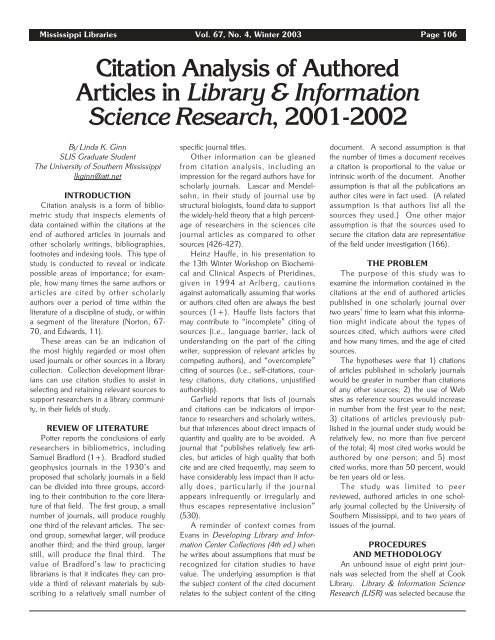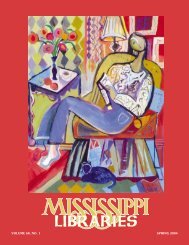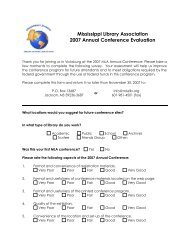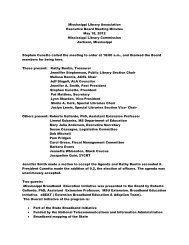Full Text (PDF) - Mississippi Library Association
Full Text (PDF) - Mississippi Library Association
Full Text (PDF) - Mississippi Library Association
You also want an ePaper? Increase the reach of your titles
YUMPU automatically turns print PDFs into web optimized ePapers that Google loves.
<strong>Mississippi</strong> Libraries Vol. 67, No. 4, Winter 2003 Page 106<br />
Citation Analysis of Authored<br />
Articles in <strong>Library</strong> & Information<br />
Science Research, 2001-2002<br />
By Linda K. Ginn<br />
SLIS Graduate Student<br />
The University of Southern <strong>Mississippi</strong><br />
lkginn@att.net<br />
INTRODUCTION<br />
Citation analysis is a form of bibliometric<br />
study that inspects elements of<br />
data contained within the citations at the<br />
end of authored articles in journals and<br />
other scholarly writings, bibliographies,<br />
footnotes and indexing tools. This type of<br />
study is conducted to reveal or indicate<br />
possible areas of importance; for example,<br />
how many times the same authors or<br />
articles are cited by other scholarly<br />
authors over a period of time within the<br />
literature of a discipline of study, or within<br />
a segment of the literature (Norton, 67-<br />
70, and Edwards, 11).<br />
These areas can be an indication of<br />
the most highly regarded or most often<br />
used journals or other sources in a library<br />
collection. Collection development librarians<br />
can use citation studies to assist in<br />
selecting and retaining relevant sources to<br />
support researchers in a library community,<br />
in their fields of study.<br />
REVIEW OF LITERATURE<br />
Potter reports the conclusions of early<br />
researchers in bibliometrics, including<br />
Samuel Bradford (1+). Bradford studied<br />
geophysics journals in the 1930’s and<br />
proposed that scholarly journals in a field<br />
can be divided into three groups, according<br />
to their contribution to the core literature<br />
of that field. The first group, a small<br />
number of journals, will produce roughly<br />
one third of the relevant articles. The second<br />
group, somewhat larger, will produce<br />
another third; and the third group, larger<br />
still, will produce the final third. The<br />
value of Bradford’s law to practicing<br />
librarians is that it indicates they can provide<br />
a third of relevant materials by subscribing<br />
to a relatively small number of<br />
specific journal titles.<br />
Other information can be gleaned<br />
from citation analysis, including an<br />
impression for the regard authors have for<br />
scholarly journals. Lascar and Mendelsohn,<br />
in their study of journal use by<br />
structural biologists, found data to support<br />
the widely-held theory that a high percentage<br />
of researchers in the sciences cite<br />
journal articles as compared to other<br />
sources (426-427).<br />
Heinz Hauffe, in his presentation to<br />
the 13th Winter Workshop on Biochemical<br />
and Clinical Aspects of Pteridines,<br />
given in 1994 at Arlberg, cautions<br />
against automatically assuming that works<br />
or authors cited often are always the best<br />
sources (1+). Hauffe lists factors that<br />
may contribute to “incomplete” citing of<br />
sources (i.e., language barrier, lack of<br />
understanding on the part of the citing<br />
writer, suppression of relevant articles by<br />
competing authors), and “overcomplete”<br />
citing of sources (i.e., self-citations, courtesy<br />
citations, duty citations, unjustified<br />
authorship).<br />
Garfield reports that lists of journals<br />
and citations can be indicators of importance<br />
to researchers and scholarly writers,<br />
but that inferences about direct impacts of<br />
quantity and quality are to be avoided. A<br />
journal that “publishes relatively few articles,<br />
but articles of high quality that both<br />
cite and are cited frequently, may seem to<br />
have considerably less impact than it actually<br />
does, particularly if the journal<br />
appears infrequently or irregularly and<br />
thus escapes representative inclusion”<br />
(530).<br />
A reminder of context comes from<br />
Evans in Developing <strong>Library</strong> and Information<br />
Center Collections (4th ed.) when<br />
he writes about assumptions that must be<br />
recognized for citation studies to have<br />
value. The underlying assumption is that<br />
the subject content of the cited document<br />
relates to the subject content of the citing<br />
document. A second assumption is that<br />
the number of times a document receives<br />
a citation is proportional to the value or<br />
intrinsic worth of the document. Another<br />
assumption is that all the publications an<br />
author cites were in fact used. (A related<br />
assumption is that authors list all the<br />
sources they used.) One other major<br />
assumption is that the sources used to<br />
secure the citation data are representative<br />
of the field under investigation (166).<br />
THE PROBLEM<br />
The purpose of this study was to<br />
examine the information contained in the<br />
citations at the end of authored articles<br />
published in one scholarly journal over<br />
two years’ time to learn what this information<br />
might indicate about the types of<br />
sources cited, which authors were cited<br />
and how many times, and the age of cited<br />
sources.<br />
The hypotheses were that 1) citations<br />
of articles published in scholarly journals<br />
would be greater in number than citations<br />
of any other sources; 2) the use of Web<br />
sites as reference sources would increase<br />
in number from the first year to the next;<br />
3) citations of articles previously published<br />
in the journal under study would be<br />
relatively few, no more than five percent<br />
of the total; 4) most cited works would be<br />
authored by one person; and 5) most<br />
cited works, more than 50 percent, would<br />
be ten years old or less.<br />
The study was limited to peer<br />
reviewed, authored articles in one scholarly<br />
journal collected by the University of<br />
Southern <strong>Mississippi</strong>, and to two years of<br />
issues of the journal.<br />
PROCEDURES<br />
AND METHODOLOGY<br />
An unbound issue of eight print journals<br />
was selected from the shelf at Cook<br />
<strong>Library</strong>. <strong>Library</strong> & Information Science<br />
Research (LISR) was selected because the














